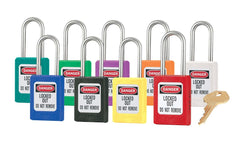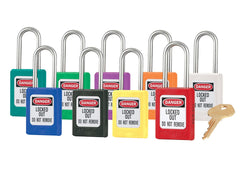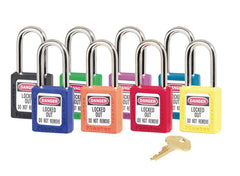Lockout Padlocks
More information about Lockout Padlocks
Our range of Lockout Padlocks is designed to enhance your Lockout Tagout (LOTO) procedures and ensure maximum safety in your workplace. At First Mats, we provide an extensive selection of padlocks in a variety of colours and body materials to meet all your needs. Enjoy peace of mind with our excellent customer service and fast delivery on all orders, ensuring you receive the best products when you need them most. Explore our range today and strengthen your commitment to workplace safety.
Our Electrical Lockout Padlocks offer more than just safety; they are built for convenience too. Features such as key retention and master keying simplify managing access to multiple electrical zones. Made with resilient materials such as stainless steel and nylon bodies, these padlocks are engineered to endure challenging environments, ensuring sustained efficiency. Dive into our collection and discover why businesses across the UK trust our Electrical Lockout Padlocks for their electrical safety needs.
Don't take chances with electrical safety in your business. Choose our Lockout Padlocks for a sturdy, dependable, and user-friendly way to safeguard your valuable assets. Explore our assortment today and find the ideal padlock tailored to your business requirements.
What is a lockout padlock?
A lockout padlock is a specially designed padlock that prevents unauthorised access to equipment or machinery during maintenance or repair work. It is typically used in industrial settings to isolate energy sources and ensure worker safety.

Lockout padlocks are made from durable materials such as steel and are designed to be highly visible and easily identifiable. They often come in bright colours and have labels or tags attached to them for easy identification. Some lockout padlocks also have additional features, such as key retaining mechanisms, which prevent the padlock from being removed until all energy sources have been properly isolated.
Using lockout padlocks is an effective way to comply with health and safety regulations and prevent workplace accidents. They indicate that equipment is being serviced or repaired and should not be operated. By investing in lockout padlocks, you can ensure the safety of your employees and protect your business from potential liabilities.
Why are Lockout Padlocks Essential for Workplace Safety?
Lockout Padlocks play a crucial role in enhancing safety in the workplace. They prevent machinery from being unintentionally switched on during maintenance, averting potential accidents. These padlocks are colour-coded and can be assigned to specific employees, ensuring that only authorised personnel can access the equipment. By effectively identifying and locking out hazards, Lockout Padlocks contribute to a safer working environment.
What Types of Lockout Padlocks are Available?
First Mats offers a wide range of electrical safety padlocks to meet your needs. From basic Zenex Safety Lockout Padlocks, designed with non-conductive Zenex material, to Heavy-Duty Stainless Steel and Nylon Body options. To enhance safety, consider adding lockout tags to your toolkit, which should be used as part of your lockout processes.
Things to Consider
- Security Level: When purchasing lockout padlocks, it is important to consider their security level. Look for padlocks that offer high-security features such as hardened steel shackles, anti-pick mechanisms, and tamper-proof designs to ensure maximum protection against unauthorised access.
- Keying System: Opt for padlocks that offer a master key system or a keyed-alike padlock, which allows for convenient management and reduces the number of keys required. Combination padlocks can remove the need for a key altogether.
- Durability: Ensure that the lockout padlocks are made from high-quality materials that can withstand harsh environments and frequent use. Look for padlocks with corrosion-resistant coatings and sturdy construction to ensure long-lasting performance.
- Compliance: Check if the lockout padlocks comply with relevant safety regulations and standards, such as the Health and Safety Executive (HSE) guidelines in the UK. Choosing compliant padlocks ensures that your lockout procedures meet legal requirements and maintain a safe working environment.
- Colour Coding: Consider purchasing lockout padlocks in different colours to enable easy identification and categorization. Colour coding helps streamline lockout procedures and prevents confusion, especially when multiple lockout devices are used.
- Size and Shackle Clearance: Ensure the padlock body height and shackle diameter are suitable for the equipment to which it will be attached. Padlocks with adjustable shackle clearance provide flexibility and compatibility with different lockout points.
- Ease of Use: Look for features such as smooth operation, ergonomic design, and user-friendly key access to ensure that employees can easily and efficiently implement lockout procedures without any hassle or confusion.
Frequently Asked Questions
What is the difference between lockout and tag out?
Lockout and tag out are important safety procedures to prevent accidental startup or release of energy during maintenance or repair work. Lockout involves physically locking the energy-isolating device with a padlock, ensuring that the equipment cannot be operated until the lock is removed. This clearly indicates that the equipment is being worked on and should not be used.
Conversely, tag out involves using a tag or label to indicate that the equipment is being serviced or repaired. While tag out alone does not physically prevent equipment operation, it serves as a visual warning to others that the equipment should not be used.
Both lockout and tag-out procedures are crucial for ensuring the safety of workers and preventing accidents. It is recommended to use a combination of lockout and tag-out procedures to provide the highest level of safety.
What are the requirements for lockout tagout locks?
Lockout tagout locks are an essential tool for ensuring the safety of workers in various industries. In the UK, there are specific requirements that these locks must meet to comply with safety regulations.
- Lockout tagout locks should be durable and made from high-quality materials to withstand harsh industrial environments. They should also be resistant to corrosion and tampering, ensuring long-lasting performance.
- Secondly, these locks should have a unique key or combination system to prevent unauthorised access. This ensures that only authorised personnel can remove the lock, enhancing safety measures.
- Additionally, lockout tagout locks should be easily identifiable with bright colours and clear labelling. This lets workers quickly identify which equipment or machinery is locked out, preventing accidents and injuries.
- Lastly, these locks must be compatible with various energy sources, such as electrical, hydraulic, or pneumatic systems. This versatility ensures that lockout tagout procedures can be effectively implemented across different industries.
By meeting these requirements, lockout tagout locks provide a reliable and effective solution for maintaining worker safety during maintenance or repair work.
First Mats Choice
-
 Basic Zenex Safety Lockout Padlocks
Basic Zenex Safety Lockout Padlocks

["Highly durable Zenex material","Resistant to moisture and UV","Available in 9 colours"]
2 to 3 days £20.50 Excl. VAT -
 Key-Retaining Zenex Safety Lockout Padlocks
Key-Retaining Zenex Safety Lockout Padlocks

["Weight Capacity: Lightweight","Non-conductive Zenex Body","Customisable Write-on Labels"]
2 to 3 days £20.50 Excl. VAT -
 Heavy-Duty Safety Lockout Padlocks - Individual Key
Heavy-Duty Safety Lockout Padlocks - Individual Key

["Heavy-duty design","100000 unique combinations","8 different colours"]
2 to 3 days £20.50 Excl. VAT



